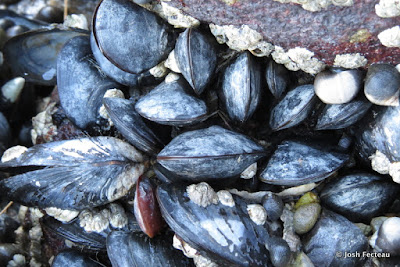Blue mussels, also known as edible mussels, were once so bountiful in the South River that people would come from Boston and points beyond to harvest them for commercial use. Such harvesting was done with barge-like equipment, using a process similar to dredging to collect these blue-shelled mollusks from the river bottom.
Mussels have long been a culinary delicacy in Europe, prized for their sweet, nut-like flavor. In recent years they have gained popularity on our own shores, and are now a common appearance at fish markets and seafood restaurants.
Blue mussels make their home in coastal waterways, including beach areas, harbors, and the North, South, and Jones Rivers. They can be found on the East Coast as far north as the Arctic Circle, and as far south as the Carolinas. Unfortunately, poor water quality at many of our local shellfish beds prevents us from harvesting mussels safely for consumption — they are extremely susceptible to fecal coliform contamination.
Known in some circles by their Latin name, Mytilus edulis, blue mussels live in colonies or bars, clustering on docks, jetties, or just about any other solid object between the high and low tide lines. They can also be found along the rocky bottoms of tidal beds. Often other marine creatures such as polychaete worms and small crustaceans take shelter within these mussel bars.
Mussels tend to colonize the same areas as barnacles, competing fiercely for space. Within three months, a cluster of mussels can easily outgrow and smother a barnacle colony. This would present grave danger for barnacles, except that mussels cannot handle the extreme conditions of the upper portion of the barnacle zone. So while mussels may take over up to half of the barnacle habitat in any given area, they will never completely conquer it.
In turn, mussels must be wary of their own predators — green crabs, dog whelks, and starfish, among others.
Mussels produce strong “byssal” threads with which they attach themselves in dense masses to solid structures, or to each other. These “anchor lines,” spun from a special gland in the foot, are important because without them mussels would not be able to survive the heavy wave action common to their habitat. Additional threads can be produced when needed.
Another survival tactic comes in the shape of the blue mussel’s shell, and the way this creature positions itself when it attaches to a surface. By pointing its shell’s narrow end into the surf, the mussel minimizes its chances of being damaged by breaking waves.
Because blue mussels lead a stationary life, attached to a rock, piling, or other solid object, they cannot go out and search for food. Thus, food must come to them, via water. Areas with abundant wave action or tidal current are ideal for mussels, as they provide exposure to maximum quantities of water.
Like the barnacle, the blue mussel is a filter feeder. Using a siphon, it inhales water into its mantle area, passing it over mucus-coated gills which collect food. The food is transported by hair-like cilia to the mouth.
The gills, relatively large in comparison to those of other mollusks (likely because of their dual purpose), are also important for the blue mussel’s respiratory functions. After being strained for food, water continues over the gills, where oxygen exchange takes place. Finally, the water is exhaled from the body through another siphon, taking any waste products with it.
Although this siphoning process is its primary means of food-gathering, the mussel can also find nourishment in the detritus that settles on its shell. The mussel uses an extendible foot to clean its shell periodically, scraping off any potential food, and passing it over its gills into its mouth.
When provided with an oxygen-rich water environment, mussels grow quickly. Spawning season begins in the winter, when temperatures are cold yet increasing. Both sperm and eggs are released into the water and left on their own to pair up.
The larvae later hatch and, if they are strong or cunning enough to survive seasonal changes and predation, eventually settle to the ocean or river floor, growing into miniature mussels. As larvae, they may have been swept by the moving water far away from shore. Before establishing themselves, they must employ their foot to move to a suitably sturdy place.
Blue mussels can grow up to 4 inches long and 2 inches high. Their shells are long, rounded, and somewhat triangular, with coarse growth lines, ranging in color from blue-black to violet to blue, with a black edge. The interior of the shell is pearly white.
Look for their vibrantly-colored shells along the shoreline, among the less noticeable clams and periwinkles.
by Kezia Bacon
Assistant Director, North and South Rivers Watershed Association
July 1997

